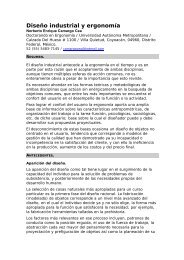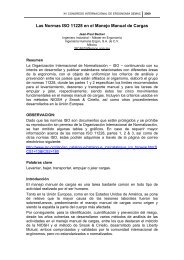ERGONOMÍA OCUPACIONAL - SOCIEDAD DE ERGONOMISTAS ...
ERGONOMÍA OCUPACIONAL - SOCIEDAD DE ERGONOMISTAS ...
ERGONOMÍA OCUPACIONAL - SOCIEDAD DE ERGONOMISTAS ...
You also want an ePaper? Increase the reach of your titles
YUMPU automatically turns print PDFs into web optimized ePapers that Google loves.
Ergonomía Ocupacional. Investigaciones y Aplicaciones. Vol 3 2010<br />
occurs in the hand, wrist or foot. Most cases of tenosynovitis are caused by injury, infection,<br />
twisting, repetitive movement as: operate a computer, working on an assembly line, the cashier of<br />
a bank, sewing, playing musical instruments like violin or guitar<br />
(http://nlmnih.gov/medlineplus/ency/article/001242.htm)<br />
• Ganglia: it is a cyst in a joint or tendon sheath, usually in the back of the hand or wrist.<br />
(http://www.itcilo.it/actrav/osh_es/módulos/ergo/ergoa.htm)<br />
• Epicondylitis: is an inflammation of muscle attachments at the epicondyle of the elbow, the<br />
pain may appear in the muscles of the forearm and wrist. The causes that provoke are: Task force<br />
loading and repeatability, often in stressful jobs such as carpentry, plastering or bricklaying.<br />
(http://www.tiroriojano.com/lesiones/EPICONDILITIS.htm)<br />
• Crimping finger: is an inflammation of the tendons and / or tendon sheaths of the fingers.<br />
By use of air guns or staplers (International Labor Organization, 2004).<br />
• Carpal Tunnel Syndrome: presented by the type of horizontal repetitive movement and the<br />
disease that affects people. It is a Repetitive Strain Injury better documented, currently classified<br />
as compensable occupational disease in many countries. This syndrome affects the median nerve<br />
(one of the principal nerve in the wrist). Extreme cases can lead to permanent disability due to the<br />
absolute inability to flex the wrist to perform tasks as simple as operating a computer or holding an<br />
object in the hand. Affects workers who process meat or poultry, supermarket cashiers who use<br />
electronic scanners, the use of vibrating hand tools.<br />
In the United States with this syndrome each worker loses more than 30 working days, a figure<br />
higher than absenteeism from amputations and fractures. It has been estimated annual cost of<br />
these lesions in more than 100 million dollars (International Labor Organization, 2004).<br />
These injuries and illnesses caused by workplace tools and poorly designed or inappropriate<br />
usually develop slowly over months or years. However, a worker wills usually signs and symptoms<br />
for a long time to indicate that something is wrong. For example, the worker will be uncomfortable<br />
while doing their work or feel pain in muscles or joints once home after work. You can also have<br />
small muscle twitches for some time. It is important to investigate the problems of this kind,<br />
because what may begin with a mere inconvenience in some cases can end in injury or disease<br />
that severely incapacitated workers.<br />
Sociedad de Ergonomistas de México, A.C. 101




